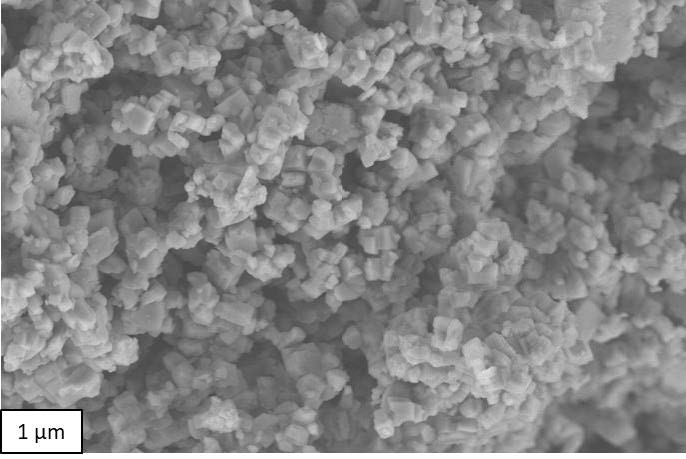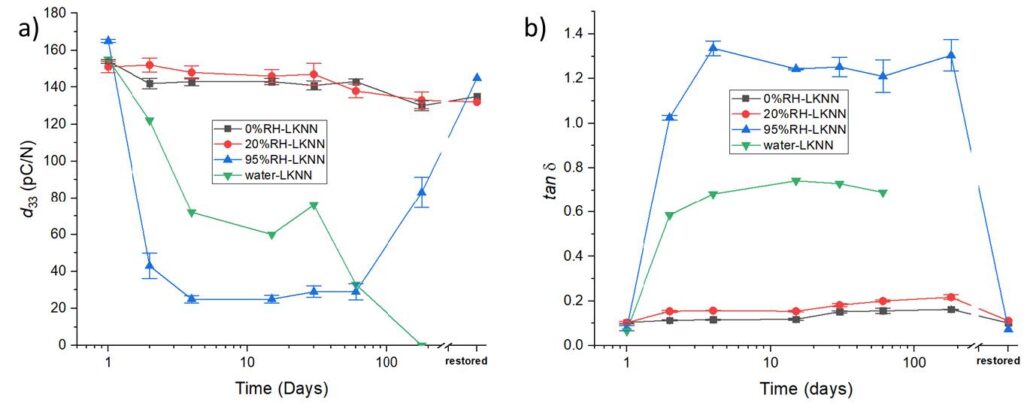New knowledge of humidity could unlock lead-free piezoelectric ceramics

Micrograph of calcined LKNN powder.
Both academia and the piezo industry are intensively researching lead-free alternatives to the piezoelectric ceramics currently enabling many technologies. Experiments conducted with a promising lead-free material have revealed that exposure to humidity during firing and storage does little to harm the material’s long-term performance.
By Astri Bjørnetun Haugen, Gianni Ferrero, Malte Aarenstrup Launbjerg and Erling Ringgaard
(This article was originally published by Ingeniøren in Danish. It has been translated and published here with the consent of their editorial group.)
The harmful effects that lead has on human health and the environment are well-known and well-documented. Consequently, the material is highly regulated on the European electronics market by the EU Reduction of Hazardous Materials (RoHS) directive. Certain applications, however, are exempt from the restrictions, and among them, we find piezoelectric ceramics.
For the uninitiated, piezoelectric materials are capable of converting mechanical energy to electrical energy (the direct piezoelectric effect) and vice versa (the converse piezoelectric effect).
The direct effect is utilized in sensors where physical stimuli are converted to an electric signal whereas the converse effect is mainly used generate (ultra)sound waves since exposing a piezoelectric material to an electric field can make it vibrate.
In certain applications, both effects are utilized which is the case with ultrasound scanners for instance. Here, a piezoelectric transducer initially emits ultrasonic waves by means of the converse effect. When a portion of the waves are reflected by body tissue, the transducer will register the echo and convert it to electrical signals which can then be used to generate accurate images of the inner parts of the body.
Piezoelectricity arises in several naturally occurring single crystals, but also in man-made polycrystalline ceramics. Lead zirconate titanate, also known as PZT, is the prevalent material on the market due to its low production cost and solid piezoelectric performance. The cause of PZT’s piezoelectric effectiveness is the high degree of polarization exhibited by the lead ions. Additionally, PZT are compatible with a range of dopants which can be added to enhance certain desired performance traits, and the material has been researched and optimized for more than 70 years.
There is, however, one severe downside to PZT: Around 60 % of its weight is comprised of lead. For that reason, both academic and industrial researchers are working intensively to develop new lead-free materials and methods of production. In a recent industrial Ph.D. dissertation from DTU Energy, written by Gianni Ferrero in collaboration with Ferroperm Piezoceramics, the largest obstacles blocking the way for the lead-free transition were addressed.
Effect of humidity during sintering
Overall, the lead-free material alternatives have yet to match traditional piezoceramics in terms of performance. There are, however, several promising candidates. In certain applications, potassium-sodium niobate (KNN) compares to and even surpasses PZT. However, issues arise when mass producing the material as it has proven hard to avoid large inconsistencies in quality from batch to batch. This is completely unacceptable in critical applications such as pacemakers and structural health monitoring equipment where inconsistent performance could have fatal consequences.
One of the main reasons for the difficulties in mass producing KNN is the alkali elements of its composition. Alkali carbonates will easily absorb moisture, leading to the creation of hydrates that can affect the phase composition of the material. Seeing as hygroscopicity is a recurring issue for the reproducibility of the material, the effect of humidity during sintering of a KNN-based compound was examined, and the results were rather surprising.
Five batches of KNN were heat treated and sintered in varying atmospheres, and subsequent testing revealed a less porous structure among the materials sintered in high humidity.
The piezoelectric properties of the materials were measured and seemed to indicate that high humidity during sintering leads to a so-called “ferroelectric hardening” as the materials’ dielectric losses dropped and their mechanical Q factor rose when the humidity increased. Additionally, of the five batches, the materials sintered in a highly humid atmosphere exhibited the greatest permittivity.
Ferroelectric hardening is typically attributed to the loss of oxides, and since humidity increases the evaporation of alkali oxides, the degree of hardening increases with humidity.
Normally, KNN is hardened by adding copper oxide (CuO), but this approach has a detrimental effect on the piezoelectric charge coefficient that describes the polarization generated in a material as a result of applied mechanical stress.
Hard piezoceramics are generally sought after for applications requiring high transfer and minimal loss of energy. Adjusting humidity during sintering could be a new method for manufacturers to harden KNN with decreasing the charge coefficient significantly.
Effect of humidity during storage
Even when fully processed, KNN remains very hygroscopic. Earlier research has shown that exposure to moist affects the material’s crystal phase, conductivity and mechanical Q factor. From an operational standpoint, this presents quite the challenge as many piezoelectric applications operate in highly humid environments (e.g., under water). Additionally, the high degree of hygroscopicity can also cause issues during storage of the material. Hence, the effect of moist exposure on KNN during long-term storage was examined.
Over a period of six months, four KNN batches were stored in different atmospheres (<0.1 ppm H20, 20 % relative humidity, 95 % relative humidity – a single batch was completely submerged in water). The batches’ dielectric losses as well as their d33 were regularly measured. On the last day of the experiment, the batches were dried for three hours at 150°C, after which their properties were once again measured.
On the second day of the experiment, the properties for the batch stored in 95 % humidity and the batch lowered into water were drastically diminished. The tendency across all batches was that their properties gradually were reduced during storage. But after being dried on the final day of the experiment, the material properties – except their coupling factors – had been almost fully restored.

Effect of humidity on d33 and dielectric losses of stored KKN materials.
The diminished properties can be explained in part by absorbed and adsorbed water molecules contributing to interface polarization. This leads to increased dielectric losses and improved conductivity. The latter affects d33 negatively due to reduced surface voltage. The reduction in properties that remained even after drying of the batches could also stem from natural aging process every material undergoes. Nevertheless, drying materials before use could be a valuable tool to improve the applicability of KNN.
Alternative source of copper oxide for ferroelectric hardening
Lead-free piezoceramics are also hampered by higher costs of raw materials compared to PZT. Even if comparable properties could be achieved and processing could be simplified, the piezoceramic industry would be reluctant to transfer to a lead-free production if the production costs would increase as a result hereof.
This affects the competitive edge of KNN as well since it is traditionally hardened via doping with copper oxide which is relatively expensive. For that reason, a three times cheaper alternative copper source that transforms into copper oxide by thermal degradation was added to a KNN formulation, and the results indicate that the cheaper alternative could be a valid substitute for copper oxide.
The doping which amounted to a 0,5 mole percentage, showed an increase in mechanical Q by a factor of six as well as an acceptable dielectric loss without drastically reducing the charge coefficient and coupling factors. As with copper oxide, the alternative copper source also reduces the sintering temperature of KNN, lowering the risk of unintentional and undesired alkali reactions.
In spite of the intensive research into lead-free piezoceramics, a complete lead-free transition of the piezo industry is not likely to transpire any time soon. According to the latest updates to the RoHS directive, piezoceramics have once again been exempt – this time until 2026. At the same time, it seems implausible that lead-containing ceramics will continue to avoid the restrictions considering their harmful effects. The strategy of the European Union will likely be to gradually limit them on certain markets and in specific applications. Hence, we are seeing the piezo industry itself spearheading the development of lead-free alternatives as has been the case with the dissertation in question. In critical applications, lead-containing ceramics will continue to be prevalent for the foreseeable future. But a lot is being done to usher in new, non-harmful materials that enable the piezoelectricity so many technologies depend upon.
 ENGLISH
ENGLISH




























































